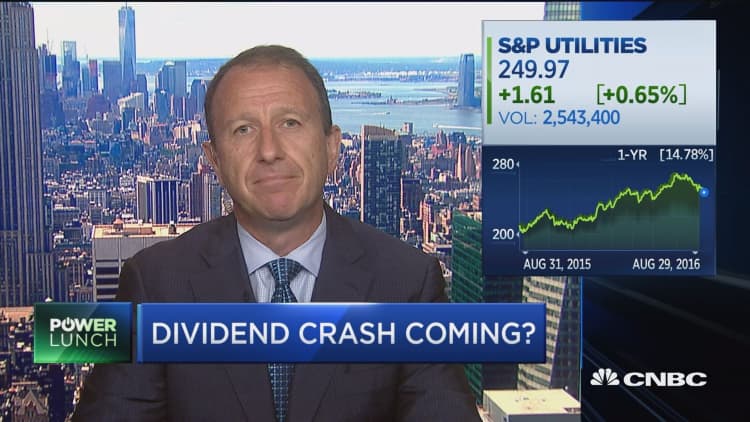Yield has been the stock market's magic word in 2016 as investors look for just about any investment to provide the income that bonds can't seem to generate anymore in a negative-yield world.
There are near-150 dividend-focused exchange-traded funds, but only one ETF company that claims the power of being able to predict where the next big dividend hikes — or cuts — will come from.
If it works, the dividend stock-picking strategy from a small California-based investment manager would give yield-conscious investors a way to capture companies that blend income with some growth, while screening out financially shaky businesses that should cut their payouts but haven't admitted it yet. It's an approach that could become more important amid market fears that dividend stock trades have become very crowded.
"There's no return in bonds, and lots of risk for something that's supposed to be a risk reducer," said Eric Ervin, CEO of San Diego-based Reality Shares. "In stocks, you could lose five years of dividends in the next 20 minutes" if companies cut dividends sharply.
Dividend stocks are already well covered by ETFs, from Vanguard's Dividend Appreciation Fund (VIG) — the biggest, with $22.6 billion of assets under management — to top performers like WisdomTree Emerging Markets High Dividend Fund (DEM) and PowerShares High Yield Equity Dividend Achievers Portfolio ETF (PEY), each of which is up 21 percent year-to-date.

Reality Shares rolled out its still-tiny ETFs this year to capitalize on the dividend wave. The ETF company says the key to its approach versus the standard dividend investing model is use of multiple measures, including cash flow, Altman Z-scores (a corporate bankruptcy risk measure) and dividend history, to come up with its predictions. Most dividend formulas rely on historical dividend trends alone.
Reality Shares Divcon Dividend Leader (LEAD) focuses on S&P 500 stocks rated at the top of the firm's proprietary scale of how likely a dividend boost is, with top holdings including Equifax, Texas Instruments and Tyson Foods. Reality Shares Dividend Defender (DFND) is 75 percent long on stocks that managers think will raise dividends, usually sporting the same top-rated stocks as Dividend Leader, and 25 percent short on companies the calculations show are likeliest to cut dividends. Reality Shares Dividend Guard (GARD) is also allowed to short stocks under its charter, but only does so when three or more sectors in the S&P 500 are flashing negative, Ervin said. Right now that fund is 100 percent long, he said.
For the latter two, the theory is that companies that grow dividends consistently tend to have returns that outpace the market while companies that cut dividends tend to lag. On the other hand, predicting stocks likely to increase dividend yields is not the same as finding stocks with the highest dividend payouts — LEAD currently has an annual yield of 1.69 percent, which is below the yield of the largest core dividend ETFs at 1.69 percent annualized (it has made only two dividend payments thus far).
"We shall see if they can identify companies that cut a dividend. It remains quite rare, and high-yielding stocks can remain high yielders for quite some time," said Todd Rosenbluth, director of mutual fund and ETF research at S&P Global Market Intelligence.
DFND and GARD have not paid any distributions to date. Quarterly distributions are authorized, though not required, for these ETFs. In the case of DFND, its short position in stocks means that the ETF can owe more in dividends in any given quarter than it is generating in dividend payouts from its long positions. It is required to pay the dividends on stocks it has shorted to its securities broker. GARD, which has been 100 percent long since May, could pay out its first dividend in the third quarter, according to Kian Salehizadeh, Reality Shares senior analyst.
Core dividend ETFs
| ETF | 1-year return | Yield | Expense ratio (%) | Assets | Holdings |
|---|---|---|---|---|---|
| Vanguard Dividend Appreciation | 16.75 | 2.07 | 0.1 | $22B | 185 |
| PowerShares Dividend Achievers | 19.24 | 2.16 | 0.58 | $297M | 272 |
| WisdomTree US Dividend Growth | 14.35 | 2.14 | 0.28 | $708M | 287 |
| iShares Core Dividend Growth | 17.35 | 2.27 | 0.12 | $644M | 426 |
| ProShares S&P 500 Dividend Aristocrats | 19.51 | 1.78 | 0.35 | $2B | 51 |
(Source: XTF.com)
Investors have yet to endorse the Reality Shares approach — each of the prediction-based dividend ETFs, which launched in January, have less than $5 million in assets.
Funds can be a substitute for trying to pick dividend stocks, said Abhishek Gupte, an analyst with Dividend.com, and in the current dividend-focused market, there may be even more reason to diversify dividend risk across more stocks. Analysts are concerned about the market's current passion for yield, saying it has led to an unsustainable rally in utility stocks and overvaluation of energy-related master limited partnerships. Gupte said some of these dividend-rich plays will have trouble sustaining their high payouts, and investors who go it alone hunting for dividends in energy stocks could get in trouble.
The Reality Shares dividend ETFs may not be for everyone, and they haven't yet put up the numbers that would draw more investors to them.
All of the Reality Shares ETFs have underperformed the S&P 500 in the past six months despite their attractive premise. The best performer, the long-only Dividend Leader, is up 7.7 percent over the last six months. The weakest, Dividend Guard, is down 2.4 percent.
Short positions in dividend stocks have gotten hurt recently by investors' desire to buy almost anything that promises yield, Ervin said. Utilities, energy and materials have been top-perfoming sectors this year, hurting the Reality Shares fund's shorts in Freeport McMoRan, Newmont Mining and Exelon.
With so many dividend funds to choose from, ETF Database analyst Kiril Nikolaev said most investors should focus on lower-than-average expenses, volatility and concentration of holdings. More than 20 percent of a fund being in its top 10 stocks is a lot, he said.
"If an ETF has 50 great stocks, the ETF and its dividend will be stable over time," Nikolaev said.
The three Reality Shares dividend ETFs covered here each hold less than 50 stocks.
If an ETF has 50 great stocks, the ETF and its dividend will be stable over time.Kiril NikolaevETF Database analyst
Vanguard's Dividend Appreciation ETF pays more than a 2.1 percent dividend yield, slightly more than the S&P 500 as a whole. Its expense ratio, at 0.10 percent, is also significantly lower than Reality Shares Dividend Leader, which is 0.43 percent. VIG's shares have returned 10.4 percent over the last six months, outpacing the S&P 500.
But Vanguard's fund charter doesn't promise to use analytics to predict dividend moves, focusing instead on companies' dividend history. And the market is traditionally not very savvy about dividends, Ervin said.
Reality Shares has built its own indexes to backtest its methodologies. The Leaders Dividend Index has risen more than fourfold since 2001, more than double the total return of the S&P. That suggests what the technique can do over time, Ervin said. It's especially strong in downturns: The index lost 40 percent of its value from the end of 2006 through the bottom of the market in 2009, which is more than 10 percentage points less than the S&P's negative total return. VIG's price dropped 42 percent over that period.
But the real star of the financial crash was the Dividend Guard methodology, which Reality Shares says would have produced a 47 percent gain. The Dividend Defender methodology would have produced a 2.3 percent loss from the end of 2006 though the bust, while the S&P lost half its value.
"When markets are going down, that's when you need the short position to hedge," Ervin said.
— By Tim Mullaney, special to CNBC.com




